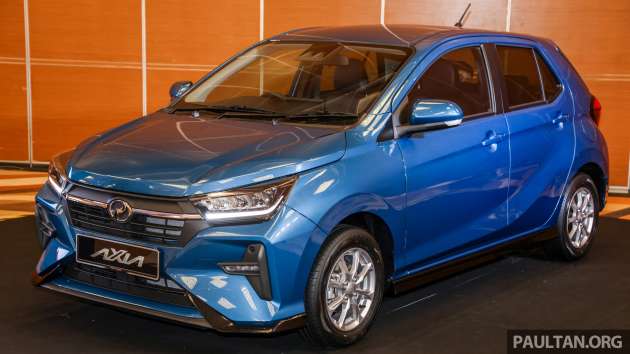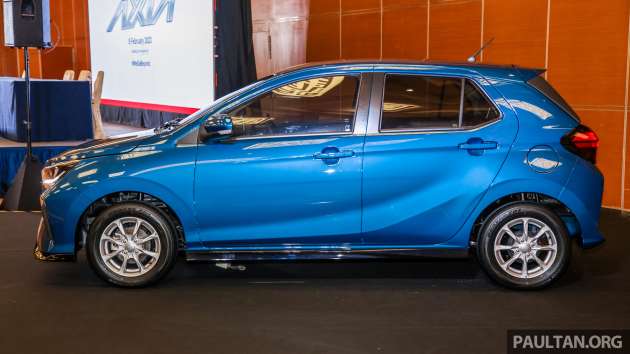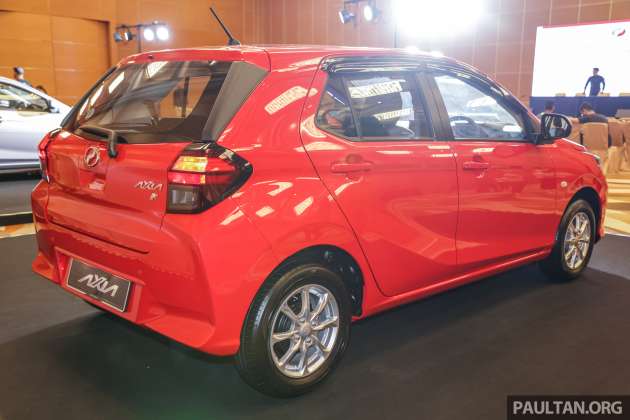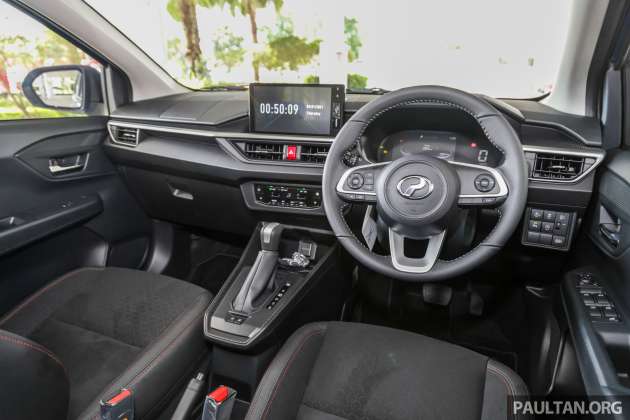2023 Perodua Axia D74A launched – 1.0L D-CVT; DNGA; larger ...

You’ve seen it (well, most of it), and some of you have even booked one, and now it’s officially launched – say hello to the 2023 Perodua Axia. The second generation to use the Axia name is an all-new model model, with a new platform, a larger footprint, a new powertrain combo and a stylish interior. It feels like a different car altogether on the move too, as detailed in our first drive report.
The Axia is a very important product for Perodua, with a lineage that tracks directly back to the Kancil, P2’s first product. The Kancil was replaced the Viva, which was succeeded by the first Axia in September 2014. In the eight plus years since then, there have been two facelifts (January 2017 and September 2019) and P2 shifted a total of 582,728 units, making the Axia one of the carmaker’s most successful products.
The Axia name is household enough for P2 to continue using it, and so here we are at the second-generation Axia. The RM546 million D74A project started in October 2019 and development took up nearly 300,000 man-hours, including assistance from Daihatsu. P2 faced unique challenges developing this model during the pandemic.
You might have noticed that Astra in Indonesia unveiled the Toyota Agya twin sister to the Axia yesterday; the ‘world premiere’ beating the Axia’s unveiling by a day. However, today’s Axia launch is not just a press preview but a full market launch – as is always the case with Perodua, the day a car is launched is the day that deliveries start. The Malaysian company is actually the lead in this shared project, which is claimed to be “designed by Malaysians to meet Malaysian/ASEAN tastes”. Mass production started in Rawang last month.
DNGA base, larger footprint

The 2023 Axia is the third model to sit on the latest Daihatsu New Global Architecture (DNGA) platform after the Ativa SUV and Alza MPV. To build a good car, you need a good foundation, and there are a myriad of benefits that a modern base can bring – read more about DNGA here.
On top of that is a body with a new design and larger footprint. The new Axia looks considerably larger in the metal, and you won’t need the previous car beside it to confirm the growth. At 3,760 mm long and 1,665 mm wide, the D74A is 115 mm longer and 45 mm wider than its predecessor; more than half of the extra length goes into the wheelbase, which at 2,525 mm, is 70 mm longer. The growth is also obvious when you look at the rearmost pillars of both Axias.
The 2023 Axia also looks lower, and the spec sheet confirms that overall height (1,495 mm) is 15 mm lower and the ground clearance (150 mm) is 20 mm less.
Old Axia on the left, 2023 Axia on the rightThe extra length doesn’t translate to more legroom though, as the Axia’s tandem distance of 910 mm was considered as good enough. Instead, boot length is up 47 mm. Almost all of the extra width is reflected in the cabin, and the 265L boot, is 5L bigger. Perodua also worked on the driving position and ergonomics – the steering angle is more upright (and less commercial vehicle) now, while the accelerator pedal position has been optimised. And finally, there’s steering tilt adjustment!
A bigger Axia makes the Myvi redundant? Not quite. Despite the Axia’s growth spurt, the ‘king’ is still 135 mm longer and 70 mm wider, even if the B-segment hatchback’s 2,500 mm wheelbase is now beaten by the Axia by 25 mm. The gap between P2’s A and B hatchbacks is now smaller, but there’s no overlap.
The problem with bigger cars and more features is weight, but thanks to the new platform – which is stronger but lighter – weight gain is minimal. AV vs AV, the new Axia’s kerb weight is 30 kg more at 890 kg. It’s still a very light car, which brings dividends at the pumps.
4AT retired, CVT takes over

Under the hood is a new powertrain combo. The carryover 1.0 litre naturally aspirated unit pushes out 67 hp/91 Nm, but the 1KR-VE three-cylinder is mated to a CVT this time around (Indonesia gets a new engine, 1.2L there because of LCGC regulations). Just like in the current Myvi, the stepless auto replaces the long-serving four-speed torque converter automatic transmission, bringing improvements in both fuel efficiency and performance with the same engine. That’s a win-win at both ends of the scale.
First introduced in the Ativa, D-CVT stands for Dual-Mode CVT, the world’s first split gear CVT system. Basically, the unit combines belt drive with a gear drive for improved FC, acceleration and quietness.
From rest to medium speeds, the D-CVT functions like any other CVT, with engine torque going through a torque converter (like Toyota and Honda CVTs; Proton’s Punch CVT uses a clutch pack) and into the input pulley, before being transferred to the output pulley via a belt and then to the wheels. At higher speeds, D-CVT shifts into its split mode, engaging the gear drive to provide more efficient power transmission (less energy loss), while the rotation to the belt drive is decreased significantly. More on the D-CVT here.
While the CVT greatly changes the driving character of the Axia, its true mission is to boost fuel economy. FC in the NEDC is up 8% from 21.6 km/l to 23.3 km/l. Perodua’s claimed figures are in the Malaysian Driving Cycle (MDC), which supposedly follows local road conditions and driving patterns. Here, it’s 25.3 km/l (G and X) or 27.4 km/l with the Eco Idle auto start-stop system (SE and AV).
P2 says that if you combine the max MDC FC with the current RON 95 price of RM2.05 per litre, you’ll only need less than RM28 of fuel to travel from KL to Penang, which is a 365 km journey. Typically, manufacturer FC claims are hard to achieve in the real world, but even if you shave off a few kilometres from 27.4 km/l, it’s still very frugal without needing assistance from a hybrid battery.
The new Axia might have a bluff face and square cut lines, but it’s somehow more aerodynamic than before (by 10%) thanks to design choices and the addition of subtle fins and spoilers. A more slippery shape enhances FC. Speaking of flow, P2 says that the new Axia comes with improved body sealing and a changed engine intake position/construction to allow for better minor flash flood wading performance.
More money, more car
Click to enlargeThe 2023 Axia comes in four variants – G, X, SE and AV. The G kicks off the range at RM38,600, the X is priced at RM40,000, the SE costs RM44,000, while the range-topping AV will set you back RM49,500. Prices are on-the-road before insurance. These final prices are identical to the estimates released on January 31.
Now, you would have noticed that the Axia’s RRP is higher than before. For reference, the launch prices of the 2019 Axia facelift were RM34,990 for the GXtra with VSC and RM43,190 for the AV. That’s a difference of around RM4k at the bottom end to RM6k for the AV, which is no small change in this segment. Also, there’s no kosong Axia E a.k.a. the driving school spec with a manual transmission.
Perodua says that they’re charging more for a bigger, safer and better car with more features, and the added value is worth RM5,800 for all variants. As for the Axia E, it’s not dead, nor is the manual gearbox. P2 has confirmed that it will continue to make the Axia E MT, which will continue to be Malaysia’s most affordable car. It won’t be a stripped out version of the D74A though, but the outgoing E, possibly with tweaked specs and a sub-RM25k price. Launching after Hari Raya Aidilfitri, which falls in April.

Back to what’s available now. VSC is now standard across the board, so there’s no more GXtra. The base Axia G is the only variant to have halogen headlamps and body coloured B pillars. There’s no keyless entry and push start, so you’ll find keyholes on the driver’s door handle and steering column. It rolls on 14-inch alloys with surprisingly sporty 175/65 Toyo Proxes CR1 tyres – this tyre/rim combo is standard across the board, and there’s no upsize for even the AV.
Inside, the G gets fabric seats, a radio with USB/Bluetooth, air con knobs, auto door lock, electric wing mirror controls, and an analogue speedo with orange lighting and a 4.2-inch trip computer. Safety wise, it’s ABS/EBD/BA, VSC, Isofix child seat mounts, reverse sensors and two airbags. The new Axia received four stars in the latest ASEAN NCAP protocol.
Raising the floor
G/X on the left, AV on the rightMoving up to the X nets you a good amount of extra kit for not a lot more cash. You gain automatic LED headlamps (with manual levelling), follow me home lights, tilt adjustable steering, front corner sensors and keyless entry with push start. The latter is of the electrostatic sensor type, as per the Ativa, and better than the Myvi’s black button. LED headlamps is new to the Axia, as is tilt adjustable steering. Some of these features, once you experience, there’s no turning back, so the X is a good place to start if your budget permits.
From the outside, you can tell the X apart from the G by the LED headlamps, which have LED positioning lamps underlining the beams. Matte black stickers on the B-pillars, too.
Next up is the SE, where style is elevated and more good stuff from costlier P2 models are present. How about LED daytime running lights, which aren’t even available on the Ativa AV and Alza AV (DRLs are bundled with GearUp bodykits). The SE also adds on a chrome strip on the grille (neatly connects the positioning lamps), a front lip and side skirts. We also spot a subtle tailgate spoiler. The wing mirrors are auto retractable and have LED repeaters.
G on the left, AV on the rightInside, the SE gets “semi-bucket seats” with chunkier bolsters, separate rear headrests (that offer more neck support over the integrated ‘pillow’ items on the G/X), a digital AC control panel (with two memory positions, as per Ativa/Alza) and a PWR (Power) button on the steering. There’s also a rev counter for the analogue meter panel. Solar/security window film, too.
The AV hits the ball out of the A-segment park, offering Axia buyers most of the goodies that Ativa/Alza AV owners are enjoying. This top shelf parts bin includes the 7.0-inch digital instrument panel (which has a few preset designs), and a 9.0-inch touchscreen head unit (from the Ativa, no Apple CarPlay/Android Auto) with steering controls, SmartLink and reverse camera. The upgraded seats get part-leather treatment here, and the steering is leather-wrapped.
The range-topper is the only Axia to get auto high beam for the LED headlamps. Safety wise, there are six airbags (front, side, curtain; previous Axia maxed out at two), lane departure warning/prevention, blind spot monitor and rear cross traffic alert. These are on top of ASA 3.0, which includes autonomous emergency braking (AEB) and front departure warning, which alerts you when the front car has moved. All this, on an Axia.
New look, are you in?
The D74A looks nothing like its predecessor, and it’s not just because of the increased size. Yes, the larger footprint gives it a more substantial look that’s far removed from the model’s kei-car lineage, but the shape is also different. The nose is super flat next to the old car’s slope, but it’s reversed at the back, where the new car’s rear screen gets an angle.
P2’s A-segment models typically have flat and plain sides, which are common for budget cars. However, the new Axia has a strong crease through the door handles plus a sweeping curve up that rises from the front wheels. That’s a lot of surfacing. The rear is also very sculpted, and it’s not just limited to the bumper too. Like the new look?
Inside, the horizontal-style dashboard has a “floating” screen design and elevated gear area. It’s good that variants without the actual screen have a slim head unit, unlike the unsightly big radio on the Ativa X. The centre stack and screen are angled towards the driver, which is another nice touch. The dash gives a good impression of width and looks very contemporary, a bit sporty even. Full side-by-side, new vs old comparison post here.
The new Axia is available in five colours – Granite Grey, Lava Red, Glittering Silver, Ivory White (solid) and Coral Blue. The latter is a new-to-P2 shade and also the hero colour for the D74A. If you’re wondering, there’s no GearUp bodykit for now; later perhaps. To recap, the Axia G is priced at RM38,600, the X is RM40,000, the SE is RM44,000 and the AV tops the range at RM49,500, all The standard Perodua warranty is for five years or 150,000 km.
Here’s what we think of the new Axia’s design and drive, what’s your take? Check out the walk-around video and galleries below and tell us.
2023 Perodua Axia G – RM38,600
Gets as standard:
Mechanicals
1.0L VVT-i three-cylinder engine (1KR-VE) 67 hp at 6,000 rpm, 91 Nm at 4,400 rpm 25.3 km/l fuel consumption in Malaysian Driving Cycle (23.3 km/l NEDC) D-CVT automatic transmission 33-litre fuel tank Electric power steering (EPS) 4.5-metre turning radius Manual handbrake Ventilated brakes discs (front), drum brakes (rear) 3,760 mm long, 1,665 mm wide, 1,495 mm tall, 2,525 mm wheelbase 150 mm ground clearance Five-year/150,000 km warrantyExterior
Halogen reflector headlights Signal lights on front fenders Body-coloured B-pillars, A-pillar corner and rear number plate garnish Body-coloured power-adjustable door mirrors with manual fold Front grille in full black plastic 14-inch alloys with 175/65 Toyo Proxes CR1 tyresInterior
Speed sensitive auto door lock Fabric seats Folding rear seats with fixed ‘pillow’ headrests Height-adjustable driver’s seat Non-adjustable steering wheel column Twist-to-start keyfob Full black dashboard Power windows, auto up/down for driver only Manual air con Analogue meter panel with 4.2-inch LCD multi-info display Non-touchscreen head unit with USB/Bluetooth Two speakers Urethane steering wheelSafety
Two airbags ABS, EBD, Brake Assist, Hill-start Assist, VSC, traction control Rear parking sensors Seat belt reminder, front and rear Isofix child seat anchors Four-star ASEAN NCAP rating2023 Perodua Axia X – RM40,000
Adds on:
Exterior
Keyless entry with electrostatic touch sensor Auto headlamps LED headlamps with manual levelling LED positioning lamps Follow me home lamps Blacked out B-pillars and A-pillar cornersInterior
Tilt adjustable steering Silver trim on steering Keyless push start button Rear centre cupholder Four speakersSafety
Front corner parking sensors2023 Perodua Axia SE – RM44,000
Adds on:
Mechanicals
Eco Idle auto start-stop Power mode 27.4 km/l fuel consumption in Malaysian Driving CycleExterior
LED daytime running lights Chrome strip on front grille Front skirting Side skirts Rear spoiler Black rear number plate garnish Auto folding side mirrors with LED turn signals Solar and security window tint Additional bonnet insulationInterior
Power mode steering button Semi-bucket seats, fabric Separate rear headrests Chrome door handles Silver horizontal dash trim Silver gear knob trim Digital AC control panel with memory Rev counter Anti-snatch handbag hook Two teh tarik hooks on the front seat backs2023 Perodua Axia AV – RM49,500
Adds on:
Exterior
Auto high beamInterior
7.0-inch digital instrument panel with steering controls 9.0-inch touchscreen head unit with steering controls Semi-leather seats Leather-wrapped steeringSafety
Six airbags Lane departure warning and prevention Blind spot monitor Rear cross traffic alert ASA 3.0 including AEB Reverse cameraGALLERY: 2023 Perodua Axia AV
GALLERY: 2023 Perodua Axia SE
GALLERY: 2023 Perodua Axia X with GearUp accessories
GALLERY: 2023 Perodua Axia G
GALLERY: Perodua Axia New vs Old
GALLERY: 2023 Perodua Axia brochure
GALLERY: 2023 Perodua Axia colours, official images
GALLERY: 2023 Perodua Axia AV official images
GALLERY: 2023 Perodua Axia SE official images
GALLERY: 2023 Perodua Axia X official images
GALLERY: 2023 Perodua Axia G official images
Tags: Perodua Axia 2023 D74A
































































